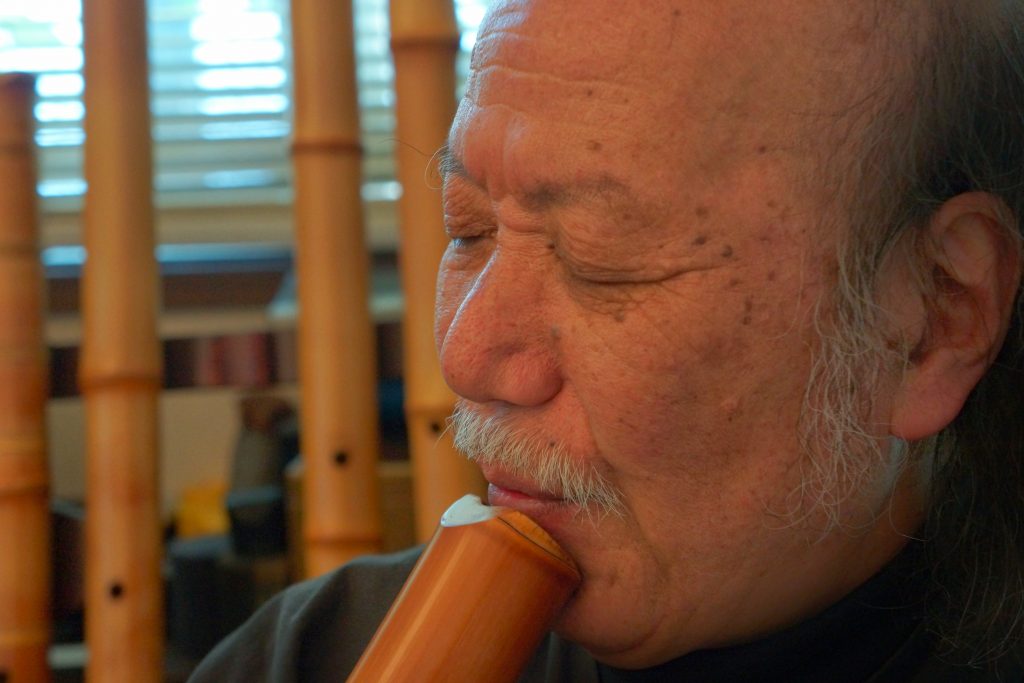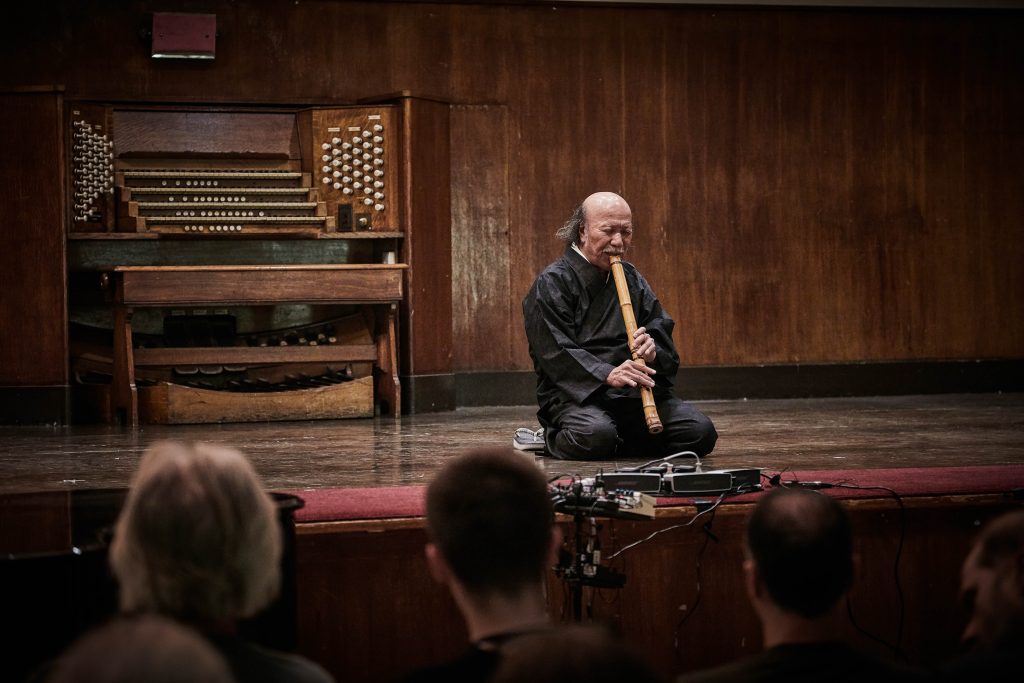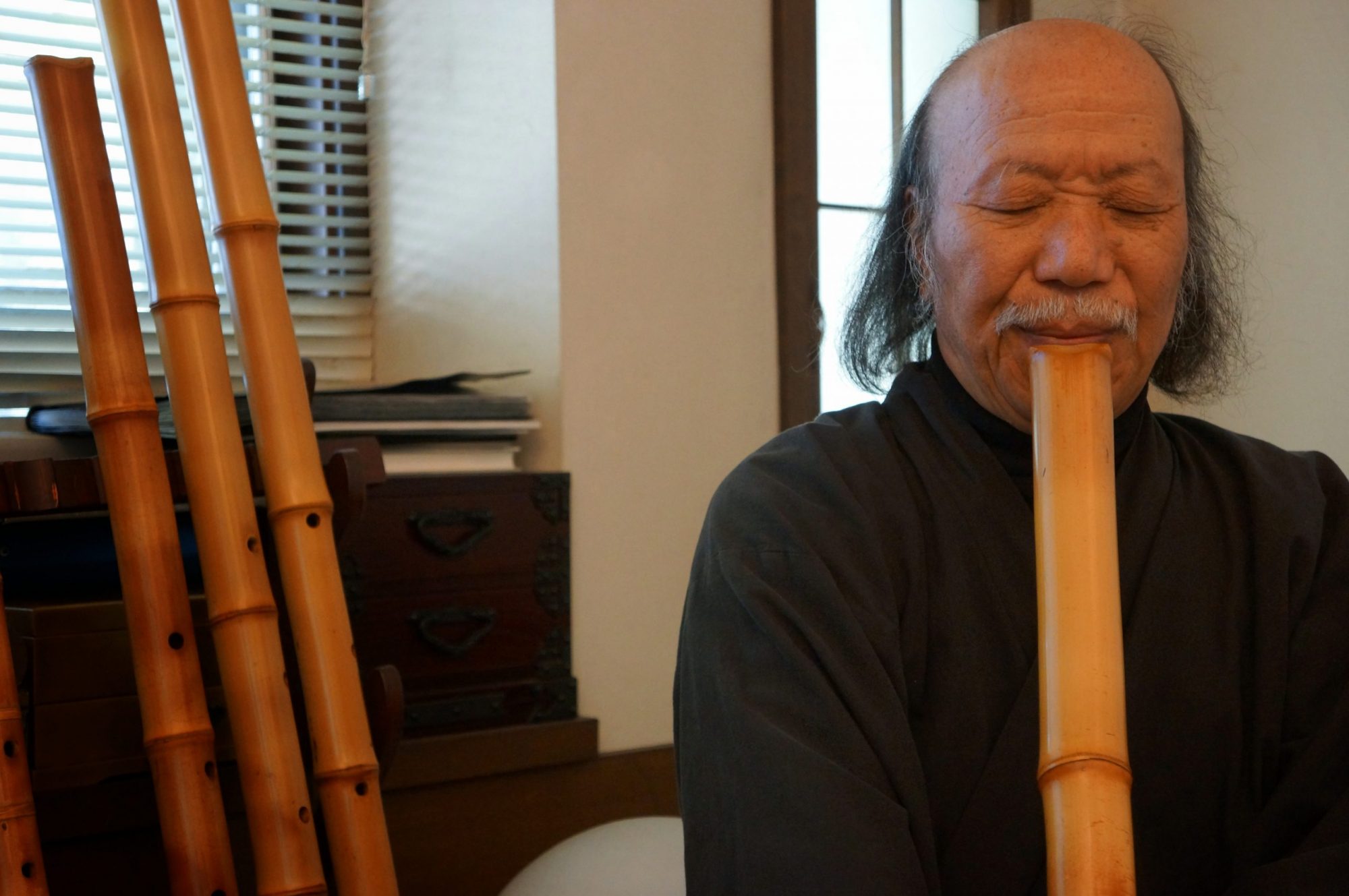
奥田敦也プロフィール:
愛知県蒲郡市出身。早稲田大学在学中にモダンジャズに傾倒、その後プロのトランペッターとして活動中、武満徹作曲「エクリプス」ノヴェンバー・スッテプス」を聴いて尺八の音に衝撃を受け、奏者である横山勝也師に尺八を師事、そこで師の父製作、尺八「蘭畝管」を譲り受ける。同時に横山蘭畝・勝也父子を通じて”海童普門”を知ることにより、「地無し延べ管尺八の無昭和59年(1984年) 岡本竹外師より「明暗蒼龍会免許印可書」を受ける。
• 昭和60年(1985年)「地無し尺八」の普及活動の一環として、気楽に聴いてもらえる空 間「禅茶房」を東京国分寺に開き、古典本曲をベースに海童道曲についても研究。以降、「禅茶房」は指導と普及の場となる。
• 昭和63年(1988年)春と秋、年2回の「禅の音研究会」が始まる。(以降、毎年開催)
• 平成2 年(1990年)自ら竹藪で竹を採り尺八を作るための「竹採り会」を群馬県にて実施。以降、毎年開催。(平成6年からは長野県に竹採り場所を移動)
• 平成3 年(1991年) 4月「禅茶房調べ会」設立
• 平成3 年(1991年) 11月第32回国分寺市民文化祭に初めて「国分寺市古典尺八連盟」として参加。以降毎年国分寺市いずみホールにて「古典尺八演奏会」を開催。
• 平成7 年(1995年) CD「禅の音」リリース(平成14年度文化庁芸術祭参加)
• 平成14年(2002年) この録音は橋本雄二氏プロデュースによるもので、以下は氏による”制作ノート”「驚きの録音ー古典本曲・三曲合奏・現代曲の録音多数経験してきて、いわゆる尺八の概念が私の中では出来
上がっていたはずだったが、奥田師の現場は驚異的な緊張に満ちたものだった。長大な曲・深遠な曲、どの曲も暗譜でノーミス!私の前に念のため広げた楽譜が生命を得て吹奏されていた。超人的なコンセントレーション(集中)が師の音楽を生かしているにちがいない。それは禅の究極のあり方に通づる。通常聴き手は受動的に音楽に対峠するが奥田師の場合、宇宙に広がるその音楽とコレスポンデンス(照応)せざるを得ない。かって永平寺貫首秦慧玉禅師から、むやみと音をもてあそぶな!と染筆を頂戴したがその意味を奥田師との出会いで私はやっと理解し得た」
• 平成18年(2006年) 国分寺市文化功労表彰受彰
スイス・チューリッヒ、オーストリア・ウイーン、カナダ・ヴィクトリア・ヴァンクーヴァ、アメリカ・カリフォルニア・バークレイ、イギリス・ロンドン、フィンランド・ヘルシンキ等、海外でも多数のコンサートとレクチャー等を行い、現在に至る。
Okuda Atsuya, Biography
Okuda Atsuya is leading player of jinashi nobekan shakuhachi which derived from the same instrument played by Edo period komuso (Buddhist monks).
Born in 1945 in Gamagori-shi, Aichi, OKUDA Atsuya was active as jazz trumpet player for 20 years since he was a student at Waseda University. He was deeply moved by composer TAKEMITSU Toru’s pieces Eclipse and November Steps and began studying shakuhachi. Okuda has studied with YOKOYAMA Katsuya from whom Okuda has received a Ranpokan shakuhachi, made by Yokoyama Katsuya’s father YOKOYAMA Ranpo. Okuda became enhcnated by Watazumi Fumon and the possibility of the infinite sound of jinashi nobekan shakuhachi. Okuda has since received Myōan Sōryukai license in 1984 from OKAMOTO Chikugai, who was considered as a walking encyclopedia of Myoan Shakuhachi. Okuda studied komosō koten honkyoku with him.
Okuda started Zensabo in Kokubunji, Tokyo in 1985 with a purpose of providing a place for the general public to enjoy the performance of jinashi shakuhachi. It was first a tea/coffee house, and while drinking tea or coffee one could listen to Okuda’s playing. Now it is only his shakuhachi dojo.
Okuda has established the following associations to support and promote shakuhachi music:
• Zensabo Kenkyūkai was established in 1988. Members gather twice a year in spring and fall to play for each other and thereby study together.
• ‘Taketori-kai’ was established in 1990. Okuda takes his students and other participants into bamboo forest in order to harvest bamboo and later make shakuhachi. The bamboo harvest was originally done in Gunma prefecture but since 1994 it has taken place in Nagano prefecture.
• Zensabo Shirabekai was established in April 1991.
• Koten Shakuhachi Association was espablished in November 1995 and gave its first Koten Shakuhachi Recital as part of Kokubunji City’s 32nd Cultural Festival. The recital has taken place annually at Izumi Hall, Kokubunji city since.
Since Okuda was honored with the Cultural Merit Award by Kokubunji-city, Tokyo, he has given number of performances and master classes both in Japan and overseas including Zurich, Switzerland; Vienna, Austria; Victoria and Vancouver, Canada; Oakland and Berkley, US, London, UK, Helsinki, Finland.
Okuda continues his contemplation of the world of jinashi nobekan and teaches at his studio Zensabo.


